Groin Muscle Strain
What is the Groin Muscle Strain?
A groin strain is an injury once you tear or overstretch (pull) a groin muscle. The groin muscles are within the area on either side of the body in the folds where the belly joins the legs. you’ll strain a groin muscle during exercise, like running, skating, kicking in soccer, or playing basketball.
Groin strain is an injury to the muscle-tendon unit that produces pain on palpation of the adductor tendons or its insertion on the pubis and pain in the adductor region on resistance testing of the adductors. Groin muscle strains are encountered more frequently in hockey and soccer.
These sports require a robust eccentric contraction of the adductor musculature during competition and practice. The underlying injury is most frequently a muscle or tendon strain at the insertion of the tendon of the adductor muscle to the bone. The adductor longus is most ordinarily injured.
Where is the groin muscle located?
The groin is a region of your hip between your stomach and thigh. it’s located where your abdomen ends and your legs begin. The groin area has 5 muscles that work together to move your leg. It is also called adductor muscles. These are called:
Adductor brevis:
- Origin:
- The anterior surface of the inferior ramus and body of the pubis, in the middle of the gracilis and obturator externus
- Insertion:
- The lesser trochanter and linea aspera of the femur (middle lip)
- Artery:
- Deep arteria femoralis
- Nerve:
- Obturator nerve
- Actions:
- Adduction of the hip
Adductor longus:
- Origin:
- the pubic body just below the pubic crest
- Insertion:
- the middle third of linea aspera
- Artery:
- deep femoral artery
- Nerve:
- anterior branch of obturator nerve
- Actions:
- adduction of the hip, flexion of hip joint
Adductor Magnus:
- Origin:
- Pubis, tuberosity of the ischium
- Insertion:
- Linea aspera and adductor tubercle of femur
- Artery:
- Deep femoral artery
- Nerve:
- Posterior branch of the obturator nerve (adductor) and sciatic nerve (hamstring)
- Actions:
- Adduction of the hip (both portions)
- flexion of hip (adductor portion)
- extension of hip (hamstring portion)
Gracilis
- Origin:
- ischiopubic ramus
- Insertion:
- tibia (pes anserinus)
- Artery:
- medial circumflex femoral artery
- Nerve:
- anterior branch of obturator nerve
- Actions:
- flexes medially rotates, and adducts the hip
Pectineus
- Origin:
- Pectineal line of the pubic bone
- Insertion:
- Pectineal line of the femur
- Artery:
- Obturator artery
- Nerve:
- The femoral nerve, sometimes obturator nerve
- Actions:
- Thigh – flexion, adduction, internal rotation
Causes of Groin Muscle Strain
- Gets stressed when it isn’t ready (for example, without a correct warm-up)
- Works too hard and gets hurt is directly injured by a blow to the world
- Groin strain is commonest among both professional and recreational athletes.
- It’s often caused by straining the adductor while kicking, so it’s more common within the athlete’s dominant leg. It also can be caused by turning quickly while skating, running, or jumping.
- Motion that needs your muscle to both lengthen and contract at the same time usually causes a groin strain. This stresses your strength and may lead them to overstretch or tear.
Although sports are the foremost common cause, a groin strain also can occur from:
- Lifting heavy objects
- Falling
- Other sorts of exercise, like resistance training
- Any overuse of a muscle can cause long-term strain.
Risk factor
- The primary risk factor for groin strain is playing a sport that involves jumping turning suddenly while running and kicking. wanting to change direction, again and again, is also a risk factor.
- The most common athletes who come into groin strain are ice hockey players and soccer players. However, athletes in many sports are often at risk. This involves tennis, basketball, skating, football, rugby, and martial arts.
- Among athletes who play these sports, a further risk factor is how much they practice during the off-season.
- Athletes who stop training during the off-season are more likely to lose muscle strength and adaptability while they’re not playing. This puts them more in danger of injuries if they begin training without taking first increases muscle strength and flexibility.
- A previous groin strain is another risk factor since the muscle is exhausted from a previous injury.
Sing and symptoms
- Symptoms of a groin strain can range from mild to severe, depending on the degree of the injury. they will include:
- Pain in the groin muscle
- Swelling and bruising within the groin area
- Decreased strength within the upper leg
- Bruising
- Difficulty walking or running without pain
- Snapping sound at the instant of injury
- Muscle spasms
- Weakness within the leg
- Pain once you bring your legs together
- Pain and tenderness within the groin and the inside of the thigh
- Pain once you raise your knee
Classification of groin muscle strain
- Grade 1:
- Mild pain, but little loss of strength or movement
- Grade 2:
- Moderate pain, mild to moderate strength loss, and some tissue damage
- Grade 3:
- Severe pain, severe loss of strength and function due to a complete tear of the muscle
Who Can Get Groin Strains?
- Anyone can get a groin strain. Things that make another likely to happen include:
- Playing sports with sprinting, bursts of speed, or instant changes in direction.
- These involve track and field (particularly the hurdle and long jump events), football, basketball, soccer, rugby, hockey, and skiing.
- Not warming up. Muscles that haven’t been warmed up and stretched properly are more likely to get injured. this is often especially true in cold weather.
- Being seeking or doing more exercise than usual. fatigue or weak muscles are more likely to get injured.
- Overstretching like those finished ballets, gymnastics, and martial arts
- Returning to activities too rapidly after a groin strain
Doctors diagnose a groin strain by:
- Asking questions about the injury
- Asking about symptoms
- Doing an exam
Assessment
Subjective assessment
- History with associated symptoms
- Mechanism of injury inciting trauma
- Direction and extent of injury force repetitious trauma
Palpation
- Tenderness
- Swelling
Treatment of Groin Muscle Strain
Medical Treatment for groin muscle strains infrequently requires surgery and still may be necessary for a complete rupture.
For immediate
- Nonsurgical, Conservative treatment maximum muscle strains do not demand surgery if the muscle is fully damaged doctors suggest surgery If there is a partial gash also the athlete can replace it when they are effortless and have normal strength and movement.
- This generally occurs following anywhere from many weeks to many months of significant treatment and therapy. When the muscle is fully damaged, the athlete may advantage from surgical repair. e tone- care of a muscle strain.
- Some therapists suggest avoiding inimical pain medicines that can extend your threat of bleeding — similar to over-the-counter (OTC) medicine (naproxen sodium (Aleve) aspirin and ibuprofen (Advil, Motrin IB), — during the first 48 hours after a muscle strain. Acetaminophen (Tylenol) and others can be helpful for pain relief during this time period.
- A physiotherapist can help you to increase the strength and stability of the injured joint or limb. Your doctor may suggest that you stabilize with a brace. For some muscle injuries, groin muscle strain surgery may be called.
The R.I.C.E approach
- To prevent swelling and pain as first aid by following RICE principal
- R- rest
- I- ice for cooling
- C-compression tapping and splinting
- E- elevation
Rest the world and avoid activities that cause pain.
For the primary day or two, put an ice gain in area 3–4 times a day for 15 minutes at a time. Put a towel between the ice and therefore the skin to protect it from the cold.
Use an elastic wrap to assist support the groin and keep the swelling down.
Raise the groin by lying down and putting pillows under the hips to up the hips and thighs.
Physiotherapy treatment
The aim of Physical therapy treatment is
- Relieve groin muscle pain
- Reduce muscle swelling
- Increases groin muscle strength
- Restore the patient’s confidence
- Restore patients’ full functional activity
Phase one: one to two week
First-week electrotherapy
- Ultrasound
- has been used for tissue healing
- Increase blood circulation and mobility.
- To reduce swelling and pain
- Cryotherapy
- Inflammation and swelling can be reduced by applying cryotherapy in form of ice packs, and cold water baths to the affected area.
- Continuous application of colds several times a day for 15-30 minutes at a time is recommended.
- TENS
- Transcutaneous electrical nerve stimulation (TENS) may be able to help reduce pain and muscle spasms.
- Interferential therapy (IFT): here are the main clinical applications for which IFT appears to be used:
- Pain relief
- Muscle stimulation
- Increased local blood flow
- Reduction of edema
Phase two: Two to four weeks
Electrotherapy
After pain relief start to exercise
Isometric and strengthing exercise for a few days
1)Adductor Squeeze (Crook Lying)
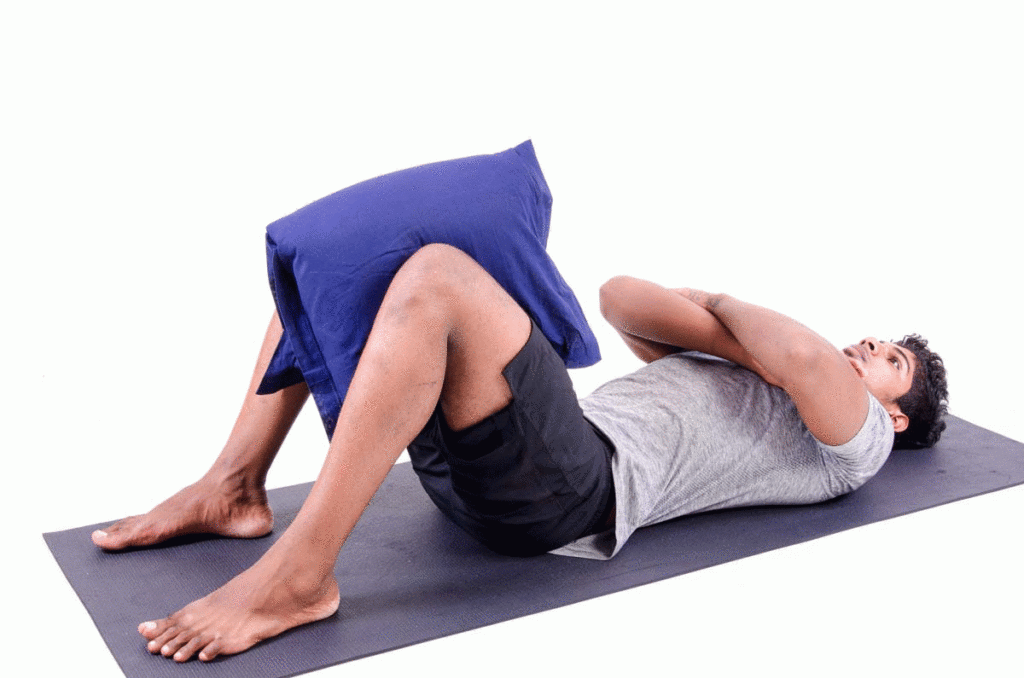
- Begin this groin strengthening exercise lying on your back within the position of knee bending with a rolled towel or ball between your knees.
- Slowly squeeze the ball in the middle of your both knees tightening your inner thigh muscles (adductors).
- Hold for 5 seconds
- Do10 to 15 repetition
2)Adductor Squeeze (Supine)
- Begin this groin strengthening exercise lying on your back in the position of a straight leg with a rolled towel or ball between your knees.
- Slowly squeeze the ball in the middle of your both knees tightening your inner thigh muscles (adductors).
- Hold for 5 seconds
- Do 10 to 15 repetitions

3)Resistance Band Hip Adduction
- Stand straight with both feet placed jointly. tie a resistance band on your ankles.
- Hold a gentle object with your hands for support. you’ll also do this without any support, counting on your fitness level.
- Keeping your left leg firmly on the ground, raise the proper leg on your side, stretching the maximum amount as you can.
- Take an interruption and bring your leg back to its initial position, releasing the strain of the resistance band.
- remain your right leg firm, raise your left leg to your sides, stretch the band, and return to the starting position.
- Repeat this exercise several times to strengthen the groin muscles and therefore the knees. It also prevents the falling of the knees during running and squatting.
- Do 2 sets of 8 reps.
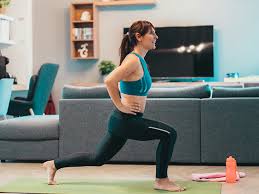
4)Lunges
- Bend the knees and lower your body until the rear knee is a few inches from the floor.
- At the underside of the movement, the front thigh is parallel to the bottom, the rear knee points toward the floor, and your weight is evenly distributed between both legs.
- Keep off up to the starting position, keeping your weight on the heel of the front foot.

5)straight leg raise (SLR)
- This is a more advanced exercise. Sit upright with feet rotated outwards. Lift one leg slightly off the bottom, move the leg outwards whilst avoiding the ground
- Return to the center, then either rest for a pair of seconds, or if strong enough take the leg out again without resting.
- This exercise progressed further by performing it on a bed with one leg relaxed down the side of the couch.
- Raise the leg upwards and across the opposite leg, lower, and repeat 8 to 10 times.
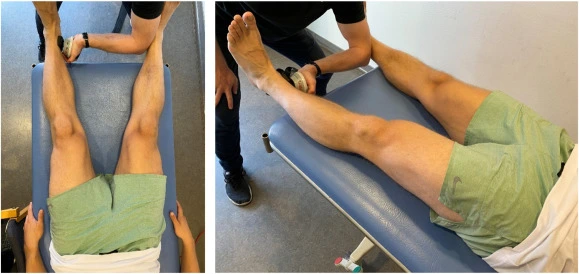
6)Eccentric adduction
- The patient sits down, legs out straight, the therapist slowly moves the leg bent to the side and the patient resists the movement but not so much that the leg doesn’t move.
- This can be done very softly at first with the therapist increasing the resistance load and intensity over time.
- Do 10 to 15 repetition
7)Hip adduction groin exercises using gravity
There are 3 different ways of performing hip adduction exercises using gravity for resistance.
- Within the first one, a chair is employed and the lower leg is raised towards the top. Hold briefly then lower and repeat. Begin with 1 set of 10 reps building to three sets of 15 reps daily.
- A slight stuff variation involves lying on your side with the top leg bent over to the front of the lower leg. The lower leg is raised as high as is comfortable, hold for a few seconds then lower.
- This works the adductor muscles within the inner range of motion.
- Finally, the foremost more complicated version brings the core muscles into play as both legs are straight lying sideways again. Raise the highest leg up then by contracting the adductor muscle and remain the core muscle firm the lower leg is raised up to meet the top leg.
- Hold for a few seconds then lower and repeat. Ankle weights are often used to increase the difficulty of any of these exercises.
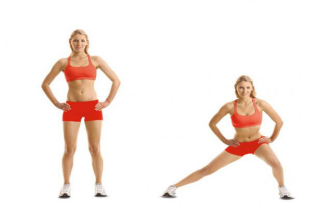
8)Side lunge
- These strengthen the groin muscles in a more functional position. By using a medicine ball in the lateral lunge (side lunge) the athlete is able to add weight to the exercise as well as use it to aid balance.
- The athlete steps to the side keeping the toes forward and the feet flat. Whilst keeping the involved leg straight, squat through the hip of the involved leg ensuring that the knee is in line with the foot.
- The athlete holds the ball out to help maintain balance. Squat as low as possible and hold for 2 seconds. Push back to the starting position.
Phase three: five to twelve weeks
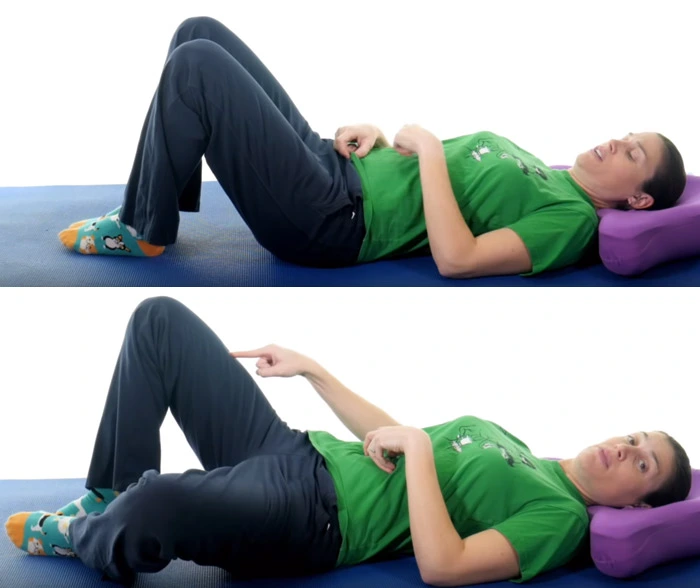
Strengthening and stretching exercises for a groin muscle
1) Lying Groin Stretch
- Lie on a mat. Support your head with an exercise pillow.
- Remain your knees flexed and feet flat on the ground and close together.
- Exhale and slowly draw your legs apart. Feel the stretch and hold it for 15 to 20 seconds.
- Don’t over-stretch. Hold it to some extent where you feel the stretch,
- You’ll place your hands on your knees to press down the knees to stretch your groin muscles.
- Inhale and convey your knees together. Do 3 sets of 5 reps.
2) Side Lying Groin Stretch
- Lie down on your right side.
- Support your head with your right hand while keeping both legs straight.
- Slowly lift your left leg in the air as much as you can.
- You may also support your knee with your left hand.
- Hold on to this position for 5 seconds to feel the stretch.
- Do 10 to 15 reps.
3) Lying Internal Adduction
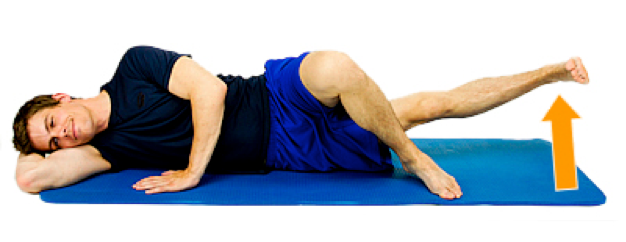
- Lie down on your left side comfortably on a mat, your head on a pillow. Place your right hand in front of you on the mat.
- Flex your right knee and place your right foot on the floor behind your left leg.
- Slowly lift your left leg. Hold this pose for 5 seconds and gently place your left leg back on the floor.
- Do this 10 to 15 times
- Lie on the other side and stretch your right leg.
4) Seated Forward Fold Stretch
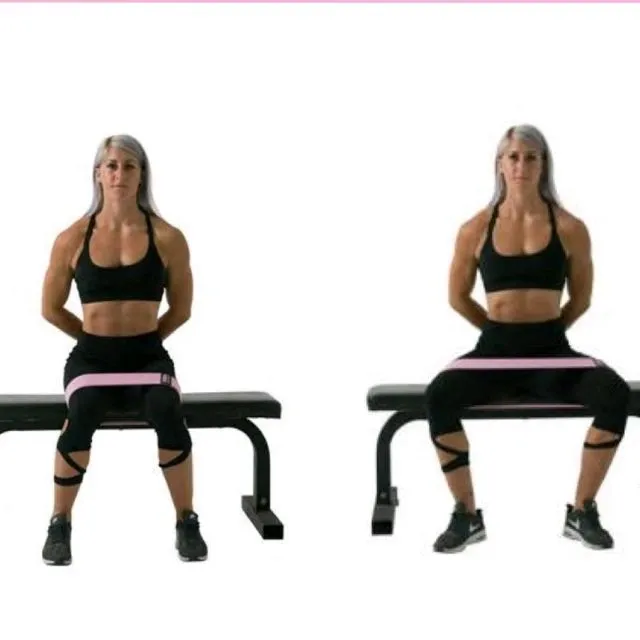
- Sit on a mat. Extend your left leg diagonally. Fold the other leg and bring it near your inner thigh groin area.
- Roll your shoulders back, extend your spine, and turn your torso slightly toward the left.
- Place your right fingertips on the floor close to the leg.
- Place your left palm on the out calf area of your left leg and feel the stretch of your hamstring, calves, hips, and groin area.
- Hold this position for 5 to 10 seconds and back to the starting position.
5) Seated Hip Abduction
- Sit on a chair or a bench. Keep your feet shoulder-width apart and place a resistance band slightly below the knees.
- Cross your arms over your chest, keep your spine erect and shoulders pinched back, and appear straight ahead.
- Open your legs outward opposite the resistance of the band. Also, open your feet, but don’t move them from their position.
- Bring the legs back to the initial position.
6) Plie Squat
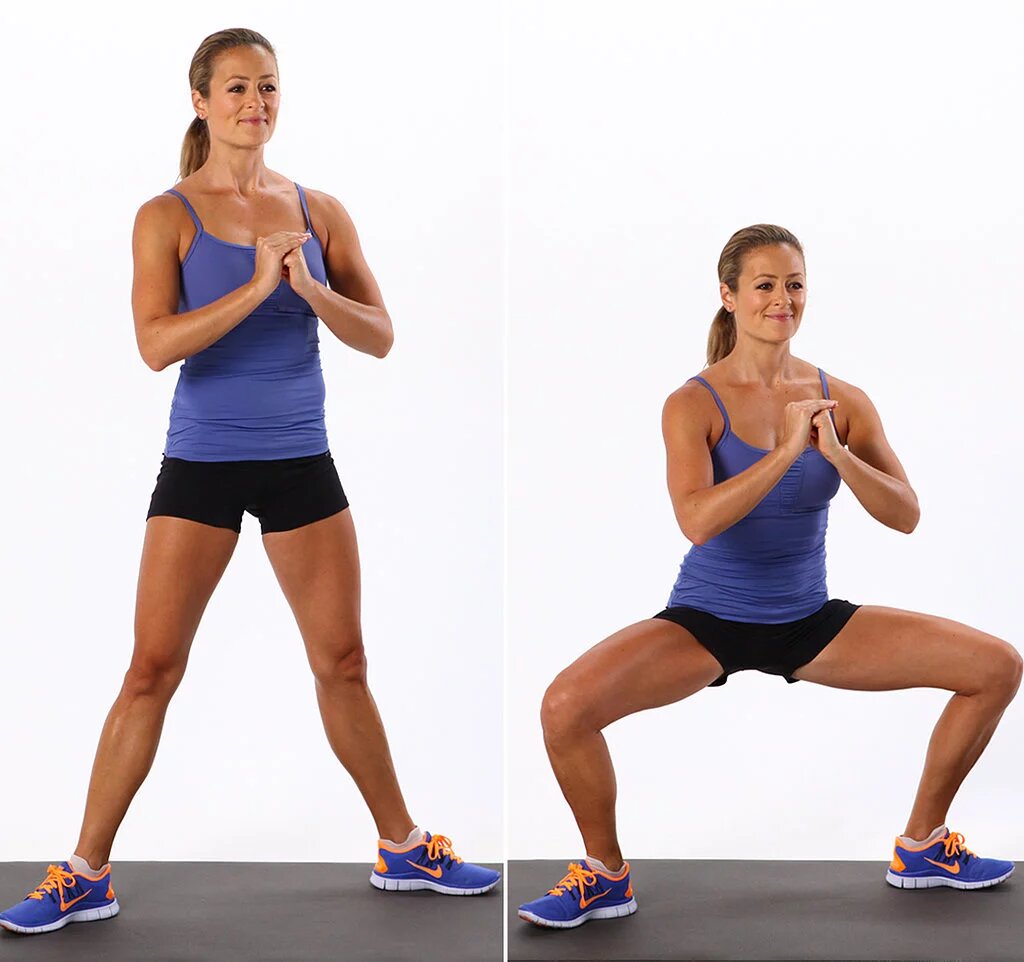
- Stand together with your hands placed on the front of your thighs, near your groin.
- Place your feet wide apart so that your toes are pointing outward on either side.
- Bend your knees and lean on your hips. Keep your weight on your heels and lift your hands straight in front of you. Your palms should be facing down.
- Hold for a flash and come back to your initial position by pushing your heels to straighten your legs.
- you’ll also do this exercise with weights in your hands to increase the intensity.
- Do 1 set of 8 reps.
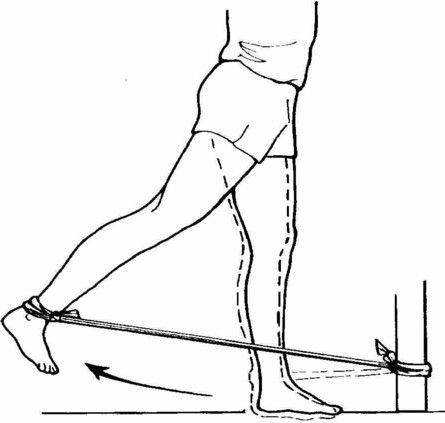
7) Hip Extension With Resistance Band
- Wrap the resistance band around your right ankle and tie the opposite end to a table leg.
- Stand straight with the knees bent a touch, hands on your waist, shoulders pinched back, and face the table.
- Pull the leg backward against the resistance given by the band.
- back to the starting position.
- do that with the left leg as well. Do 2 sets of 8 reps.
8) Long Adductor Stretch
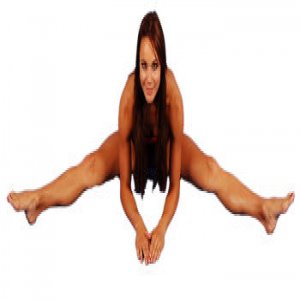
- Sit on a yoga mat together with your legs extended in front of you.
- Open up your right leg until it’s about 45 degrees with the left leg.
- Open your left leg by bringing it to the side, at about 45 degrees from the initial position.
- Use your hands to push both legs back and gently open up the legs a touch more (skip this step if you have a groin injury).
- Bend your body forward and place your forearms on the ground in front of you.
- Count to five before bringing your body back up. roll in the hay 3 times.
9) Hip Flexor Stretch
- Stand straight on a mat. Put your right leg forward and go down up to your left knee touching the mat.
- Place both your palms on the right knee, point your left toes out
- push your right knee together with your palms.
- At the same time, pull your upper body back.
- Feel the stretch in your quads, glutes, inner thighs, and abs.
- Hold 10 to 15 seconds and then come back to the starting position.
- Do the identical with your other leg.
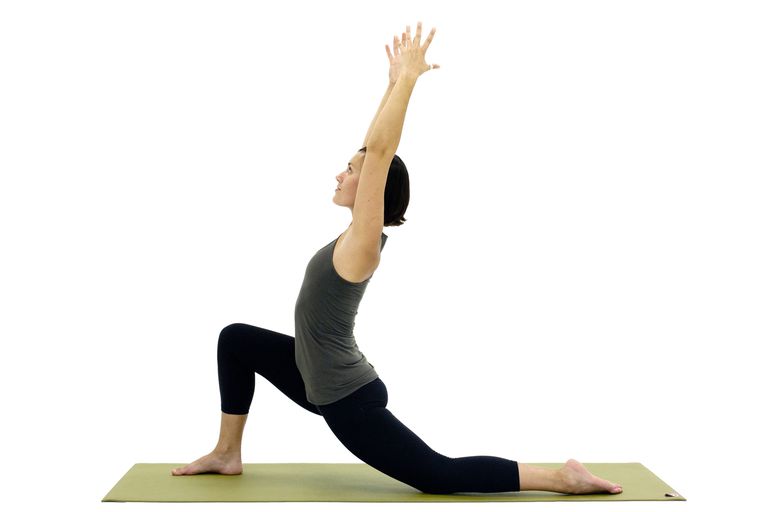
10) Anjaneyasana
- Get into a plie squat position and place your hands on your knees.
- Turn toward your left, stepping into a lunge pose. Place both hands on your left knee.
- Slowly place your fingertips on the ground for support and lower your hips. Your right leg will extend back as you are doing so. Gently place your shin and tarsal joint on the ground.
- Place your hands on the knee again. Feel the light stretch in your groin area.
- Push your hips down if the stretch isn’t enough.
- Hold 20 to 30 seconds. Keep breathing.
- Do it on the other side as well.
How Can I Prevent Groin Strain?
- Given that groin strain can be painful and debilitating, the simplest advice is to prevent it. You should:
- Always warm up your legs and groin muscles before a physical task.
- A lightweight jog or other activities to increase body temperature have been shown to reduce the risk of muscle stains.
- Wear shoes with good help that fit well.
- Always increase the intensity of your physical activity slowly — not quite a 10% increase a week.
- Stop exercising if you are feeling pain or tightness in your groin or the inside of your thigh.
- Do regular strengthening exercises for your thigh muscles, especially if you’ve had a groin strain before.
- Groin injuries may result from added stress due to weakness elsewhere. If involved in athletics and you’ve got a history of groin injuries, ask your medical professional about activities that will help reduce your risk.
FAQ
What does a groin strain feel like?
pain and tenderness in the groin and the inner thigh. pain when you raise your knee. A snapping or popping feeling during the injury, followed by severe pain
How should I sleep with a strained groin muscle?
If you sleep on your side, ignore lying on the painful leg. Place a pillow between your legs to assist support the injured area.
Should you massage a strained groin muscle?
During the rehab of both acute and chronic groin strain, physical therapy is integral to optimal recovery. Remedial massage releases tension in the muscle reduces swelling, relaxes muscle spasms, stimulates blood circulation, and realigns the muscle fibers to promote healing.
Is walking good for groin strain?
Immediately following your consultation, your physiotherapist may advise you to: Rest the area by avoiding walking or any activity that causes pain. Crutches could also be recommended to reduce further strain on the muscles when walking. Apply ice packs to the world for 15 to 20 minutes every 2 hours.
How do I treat a groin strain?
Rice principle
Rest and protect your injured or sore groin area for 4 to 5 days. Stop, change, or take an opportunity from any activity that may be causing your pain or soreness. don’t do extensive activities while you still have pain. Put ice or a chilly pack on your groin area for 10 to 20 minutes at a time.

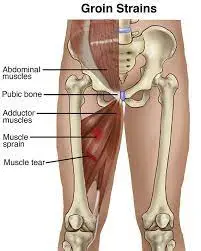

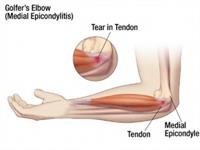
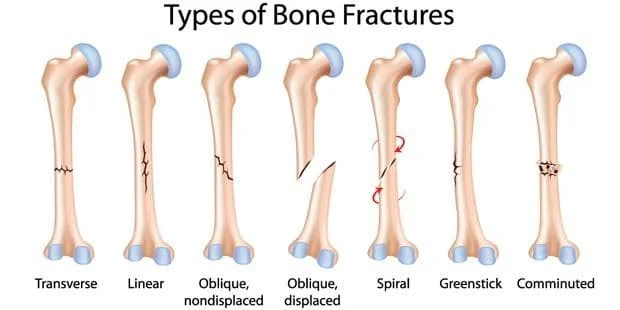
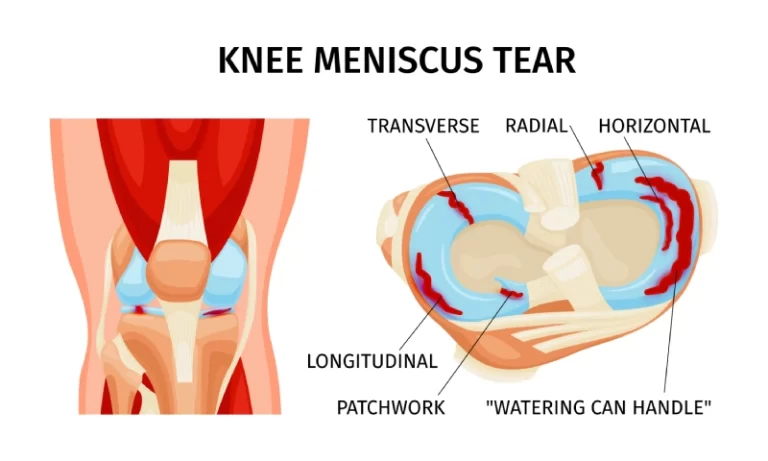

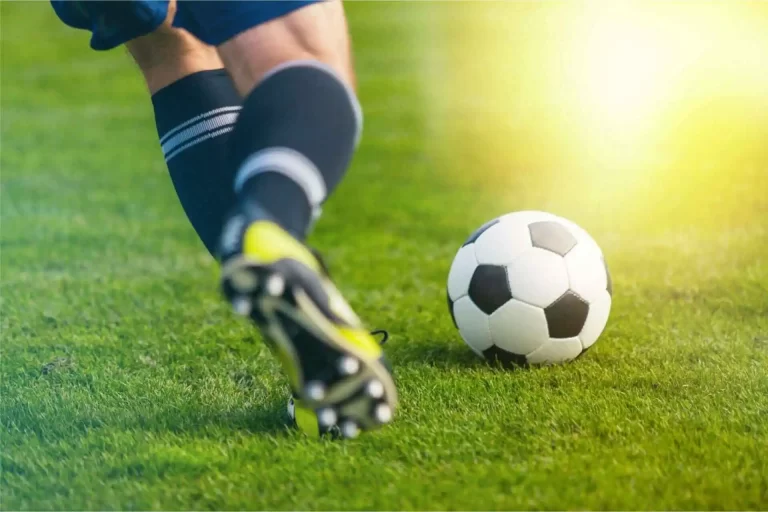
5 Comments